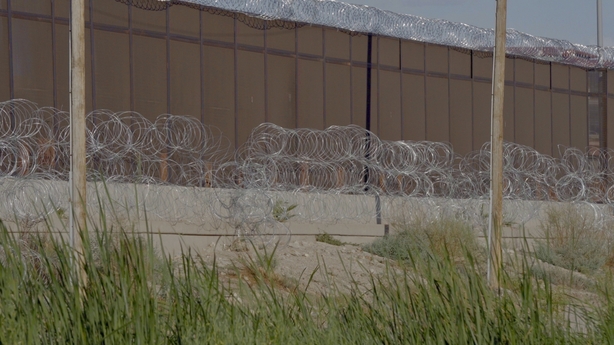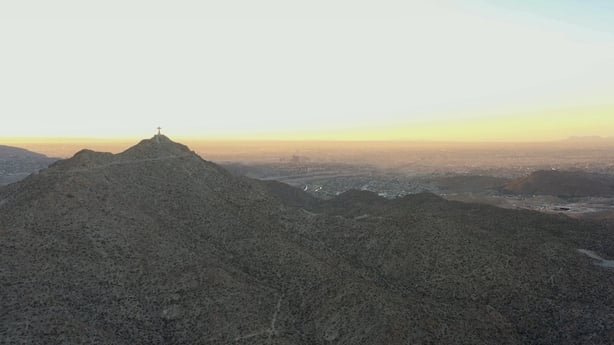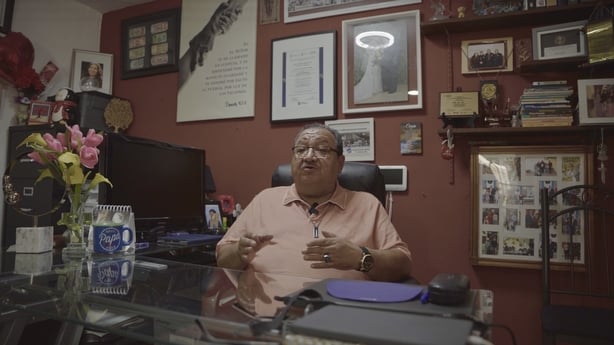The sun was rising as we made our way to the foot of Mount Cristo Rey - a mountain marked at its peak with a white stone cross.
Straddling the US-Mexico border, it's a popular crossing point for migrant-smugglers, writes Yvonne Murray in El Paso, Texas and Ciudad Juárez, Mexico.
Abandoned backpacks, clothes and water bottles littered the parched earth.
The area buzzed with US Border Patrol helicopters while a group of Mexican federal police officers, armed with automatic rifles, stood guard on the other side of the towering border fence.
Under pressure from Washington, Mexico has beefed up its border control too.
A United States Border Patrol vehicle approached as we filmed by the wall.
"Be careful," the American agent behind the wheel told us.
"Don't trust anyone south of the fence," he said, before driving off down the dusty track.
It was a reminder of the strained relations between the US and Mexico since migration soared to the top of the American political agenda.
We need your consent to load this rte-player contentWe use rte-player to manage extra content that can set cookies on your device and collect data about your activity. Please review their details and accept them to load the content.Manage Preferences
Former president Donald Trump made the southern US border a cornerstone of his presidency and is running for re-election on an anti-migration platform, vowing to stop what he calls the "invasion".
He has promised to build more sections of the border wall and enact a mass deportation of undocumented migrants.
Republicans have accused the administration of being weak on border security, zeroing in on Vice President Kamala Harris’s immigration brief early in the Biden administration.
As a result, there is no doubt that migration is now a key election issue - polls show it’s a top priority for American voters.
So Democrats too are talking tough.

In June, President Biden issued an executive order, barring migrants from claiming asylum on US soil, once a certain number of what US Border Control calls "migrant encounters" is reached.
Vice President and Democratic presidential nominee Harris has indicated she wouldn’t change current policy.
The sweeping crackdown followed the collapse of a bi-partisan bill aimed at border reform. Democrats accused former president Trump of deliberately spiking the measure, for his own political purposes.
In this febrile atmosphere, tension has been rising along the US-Mexico border.
Under Operation Lone Star, the Texas Governor Greg Abbott ordered militarisation of the border fence deploying thousands of National Guard personnel and adding bales of concertina razor wire.
On the other side of the fence, locals have watched its fortification grow over the years.
The number of crossings along the nearly 2,000-mile-long border has dropped since Biden’s asylum crackdown.
But many still try.
"The wall doesn’t stop them," Rebecca Ruiz, a long-term resident of Ciudad Juarez, told RTÉ News.

Juarez is considered one of the most dangerous cities in the world. Powerful cartels control drugs and migrant-trafficking operations.
"We have people who have already been in their immigration process for nine months and are still waiting."
Every year, several US Border Control corruption cases involving smuggling are tried in the US courts.
Migrants trapped in Juárez are easy prey for criminal gangs, according to humanitarian aid groups.
"Many of our patients have been kidnapped, sexually assaulted and robbed, often multiple times," Dr Brian Elmore an emergency medical physician in El Paso, who also volunteers with migrants in Juarez, said.
"Americans don’t realise there is very little opportunity for legal migration and given how desperate these folks are, our efforts at deterrence are just forcing more people into the desert and over the wall," Dr Elmore, who is also medical director with Hope Border Institute, added.
With daily temperatures hitting more than 38C, many migrants succumb to heat exhaustion and dehydration.
On his nightshifts, Dr Elmore said he regularly treated adults and children with broken limbs and spines sustained through falling from the wall, as well as razor wire lacerations.
"When you talk about folks climbing the wall or crossing through the desert, that’s why they do it," he said, "because they are forced to wait in an unsafe environment in one of the most dangerous cities in North America."
An application to apply for asylum must be made through an online app called the CBP One.
But the system is overwhelmed.

At a migrant shelter run by The Good Samaritan in the northwest of Ciudad Juarez, waiting times are getting longer.
"People used to be here with us for just two weeks or a month before getting processed," Juan Fierro Garcia, the director, said.
"Now we have people who have already been in their immigration process for nine months and are still waiting."
Asked about the politics surrounding migration in the United States, "people are looking to win votes in elections," he said.
"If you really think about what these migrants are dying for, they are dying for the opportunity to work in our kitchens, to mow our lawns, to educate their kids."
Fidelina Bardales travelled for a year from Honduras with two of her children.
"I miss my daddy and brothers and sisters," five-year-old Meyli said.
"Whenever night fell, I would take a blanket and wrap them in it, hide in the bushes and I would sit there watching over them while they slept," Ms Bardales said.
Her 16-year-old son was killed by gangs. They wanted to take her teenage daughter too, she explained.
So far, the family has been waiting four months for an appointment to apply for asylum.
But while both Republicans and Democrats agree that the current immigration system is broken, there’s no consensus on how to fix it.
And little will change ahead of November’s election.
The Biden administration will do everything it can to avoid migrant numbers climbing up again before Americans go to the polls.

But risks for migrants are rising.
"This summer is set to be the deadliest summer on record for El Paso for migrant deaths," Dr Elmore said.
"If you really think about what these migrants are dying for, they are dying for the opportunity to work in our kitchens, to mow our lawns, to educate their kids.
"I think as Americans we need to confront that this is the cost we have decided, as a society, to impose on seeking the American Dream," he added.






